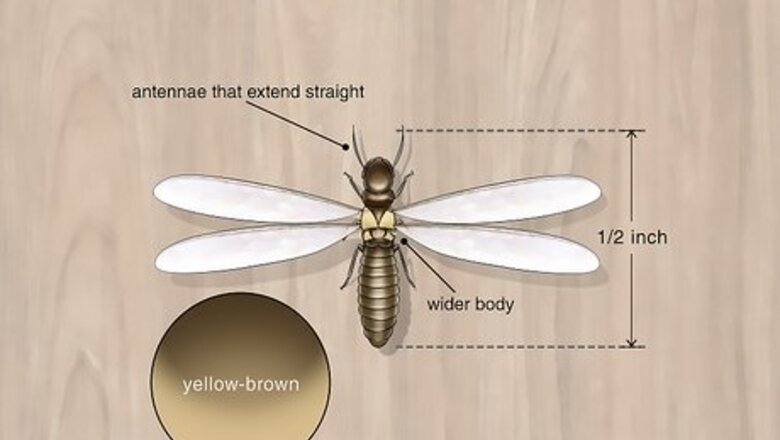
views
Dealing with Flying Termites

Identify flying termites by their wings and body shape. Termites have a wide body and wings that are the same size with lots of small veins. The insects are yellow-brown and around ⁄2 in (1.3 cm) long. Plus, they've got antennae that extend straight. If you've got subterranean termites, they usually swarm between mid-morning and mid-afternoon. Formosan termites swarm in the evening or right before dusk. Termites usually swarm between May and June although some species swarm later in the season after rainy or humid weather. If you've got an account with a pest control company, call them immediately so they can check if you've got termites.
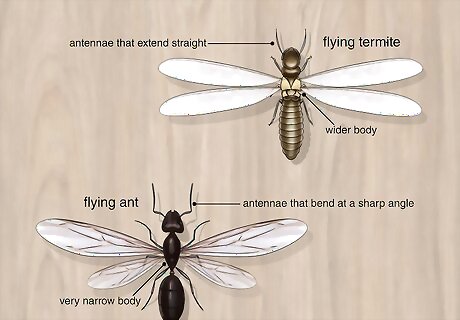
Rule out flying ants which can also swarm. Flying ants have a very narrow body and they're much darker in color. Their antennae bend at a sharp angle. If you look at the wings, you'll find that they're irregularly shaped with very few veins. Ants tend to swarm at the same time of year as termites, so it's useful to distinguish between them.

Close off the room where the termites are swarming. It can be pretty shocking to see a swarm, but don't panic! Close the doors and windows in the room so they can't spread through your home. Turn off your outside lights and close your garage doors, too so they're contained in one area while they swarm. If you're dealing with flying termites outside, don't try to spray or catch them. They'll go back in the ground within a few hours. Then, you can talk with a pest control specialist to decide if you need to treat your home. Don't try to block off the termites' exit holes since they'll simply make new ones if they can't escape through the existing holes. It's better to pay attention to where the holes are at so you can treat the infestation once the termites have stopped swarming.

Vacuum up the dead termites and throw them in the garbage. Once you no longer see the termites flying around the room, take a vacuum and suck up the dead insects. You may need to use an attachment to vacuum the dead termites along windowsills or shelves. Then, simply empty the vacuum into the trash. If you want to show some of the termites to a pest control company, keep some of the wings as a sample.
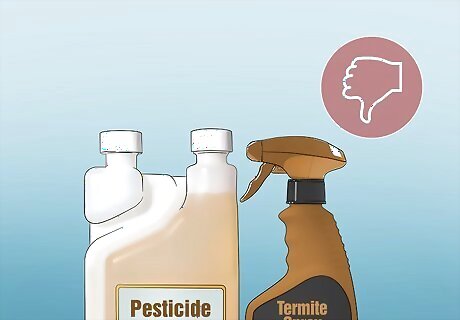
Skip pesticides or termite treatments for the swarm. The swarmers' wings will quickly fall off and they'll die without you doing anything. Don't spray pesticides or termite treatments in your home since you'll just be exposing yourself to unnecessary chemicals. Plus, killing the swarming termites won't protect your home from future termite damage. Swarming termites don't usually establish a new termite colony. Instead, they're a sign that a termite colony is already in your home.
Destroying a Termite Colony

Mix beneficial nematodes into the soil for biological pest control. You can buy the nematodes from most local garden supply stores and they work by poisoning the termites' blood. This makes them really effective—they'll kill the termites within a few days. Soak the ground after you spread the nematodes into the soil and let them get to work! Beneficial nematodes are safe to use around children and pets. They're also fine to use in your vegetable garden. Plan on using beneficial nematodes every 2 weeks to ensure that you kill all the termites and their eggs.
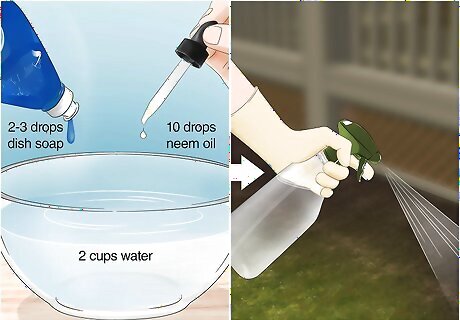
Spray a soapy essential oil mixture on the termites for a natural treatment. Although it can take a while, orange oil and neem oil will slowly kill termites. The essential oils stop the termites from laying eggs and shedding their skin. For an effective mixture, combine 2 cups (470 ml) of water with 2 or 3 drops of liquid dish soap and 10 drops of orange oil or neem oil. Pour the mixture into a spray bottle and shake it well. Then, spray it on the termite colony along with any infested wood.
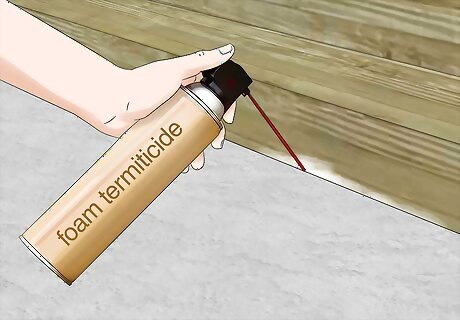
Spray a foam termiticide to kill colonies inside your home. For a fast-acting treatment, buy a foam or liquid insecticides like Taurus SC and Termidor SC. You can spray these into cracks and crevices inside your home or wherever you find a termite colony. You can even apply it to the exterior foundation of your home. Termiticide poisons the termites and they'll spread the poison to other termites in the colony, so this is a really effective treatment. If you know you're dealing with subterranean termites, you can drill holes into termite-infested wood and spray the termiticide into them. Then, fill the holes with putty and let the chemical treatment get to work.
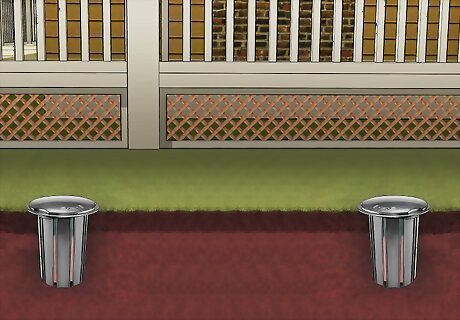
Install termite baits for long-lasting treatment. Baits look like stakes that you drive into the ground around your home's foundation. There's poison inside the long stake that slowly releases to stop the termites from growing, so they'll die when they try to molt. The poison is also spread from termite to termite, so it will wipe out the colony quickly. Baits are a good choice if you're trying to limit insecticide use. While they do use poison, baits don't need as much as traditional termite sprays.

Call a professional if you suspect widespread termite activity. You may feel uneasy about termite colonies in your home even after you've gotten rid of the swarm. After all, a lot of termite activity can happen in hard-to-reach spaces around your home. If you'd like peace of mind, hire a licensed and certified pest management professional to fumigate your home. You don't have to wait for termites to get out of hand before you call a professional. You may want to hire them even if you're dealing with a small outbreak. Dealing with them as soon as possible can prevent a lot of damage.
Preventing and Checking for Termites

Fix drainage issues and leaking faucets to deny the termites water. In addition to a food source, termites look for moisture when they make their colonies. Walk around the outside of your home and check for leaky faucets or pipes. If you've got a basement, look for ways that water could be collecting in places. You may need to level your yard if you've got a yard that slopes to direct moisture toward your foundation. Clean out your gutters and downspouts so water doesn't collect along your roof or foundation.

Keep 6 to 12 in (15 to 30 cm) of space between vegetation and your home. Don't plant flowers, shrubs, or trees right next to your home since termites will use them for food or moisture. It's totally fine to landscape your home—just leave up to 1 foot (0.30 m) of space between your foundation and your plants. Do you have plants in wooden barrels or planter boxes right next to your home? The wooden containers can really attract termites, so switch to plastic, terra cotta, or ceramic and move them away from your foundation.
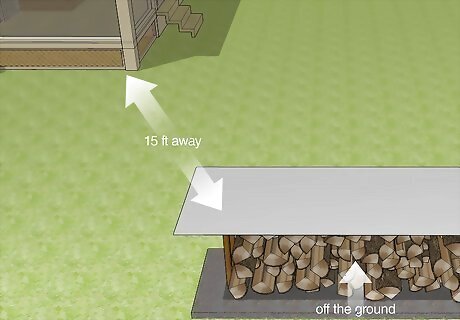
Store firewood away from your home so termites aren't attracted. If you can, keep firewood off of the ground at least 15 ft (180 in) away from your home. You should also build with termite-resistant wood if you've got a porch, deck, or patio. Pull up tree stumps instead of leaving them in your yard since they're a great food source for termites. Don't forget that mulch counts as wood! Avoid spreading wooden mulch right next to your home or you'll be feeding the termite colony.

Turn off your exterior lights in May and June. This is when swarming termites are most drawn to bright lights. You may even see them swarming around street lamps. Turn off your porch lights and any bright security lights you may have around your home. Unfortunately, flying termites might be drawn to bright lights inside your home. Draw the blinds or turn the lights down low at dusk so they're not as likely to swarm in your home.

Install termite monitoring stations in the ground around your home. The best way to get rid of termites is to deal with them at the earliest sign. Buy termite monitoring stations—these look like plastic tubes that have wood in the middle and a plastic cap on top. You'll drive them into the ground and check them at least every couple of months. To check the station, twist off the cap and pull out the wooden bait from the center. You shouldn't see any termites and the wood should be intact. If you see termites or the wood has been damaged, you'll know you've got to treat for termites. Put the stations near tree stumps in your yard, along the foundation of your home, and anywhere you've had problems with termites in the past.
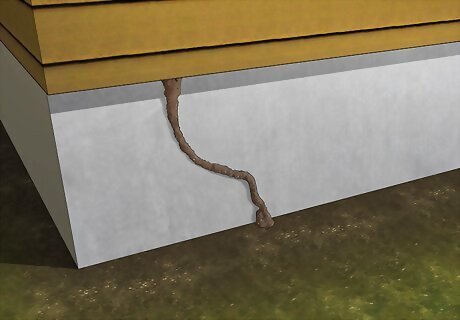
Look for mud tubes if you have an unfinished basement. Flying termites are a sign that there's a termite colony thriving nearby so make a habit of walking around your unfinished basement every day to look for thin tubes of mud and dirt along the walls. They're dark brown and look like dry clay. If you see these around your home, you know you need to treat for termites. You might also see mud tubes on the exterior of your home where the foundation meets the soil.




















Comments
0 comment